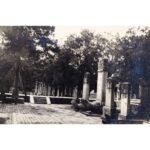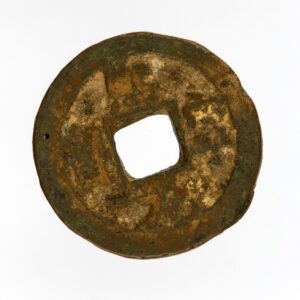Photography Memorial Archway Pailou at the Beijing Imperial Academy Guozijian
A black-and-white photograph showing the imposing multi-coloured Liuli Memorial Arch (Liuli pailou 琉璃牌楼) at the Beijing Guozijian Imperial Academy 北京國子監, just a stone’s throw from the Temple of Confucius. The Academy was founded in the year 1306. It was the highest educational institution in the Yuan, Ming, and Qing Dynasties.
The three-part memorial triumphal arch, richly decorated with glazed tiles and roof tiles, is considered the most beautiful memorial triumphal arch in Beijing. The yellow colour continues on the walls, which are surrounded by yellow and green glazed tiles. Large reliefs of a dragon and a phoenix are placed on either side of each inscription above the main passageway. The rest of the walls are painted bright red with plinths and borders of white marble hanbai yushi 漢白玉石.
The inscription 圜橋教澤 (Wu qiao jiao ze) is matched by a second 學海節觀 (Xue hai jie guan) on the other side of the memorial triumphal arch. ... more
A black-and-white photograph showing the imposing multi-coloured Liuli Memorial Arch (Liuli pailou 琉璃牌楼) at the Beijing Guozijian Imperial Academy 北京國子監, just a stone’s throw from the Temple of Confucius. The Academy was founded in the year 1306. It was the highest educational institution in the Yuan, Ming, and Qing Dynasties.
The three-part memorial triumphal arch, richly decorated with glazed tiles and roof tiles, is considered the most beautiful memorial triumphal arch in Beijing. The yellow colour continues on the walls, which are surrounded by yellow and green glazed tiles. Large reliefs of a dragon and a phoenix are placed on either side of each inscription above the main passageway. The rest of the walls are painted bright red with plinths and borders of white marble hanbai yushi 漢白玉石.
The inscription 圜橋教澤 (Wu qiao jiao ze) is matched by a second 學海節觀 (Xue hai jie guan) on the other side of the memorial triumphal arch. Both were composed by Emperor Qianlong. The first inscription can be translated as “Under the bridges of knowledge flows a river”. The second refers to the emperor’s lecture and the crowd of ministers and other listeners, which is so large that it must be separated by water. This idea is symbolised by the architectural design of the central building, the Hall of Classics (Biyong 辟雍), which is surrounded by a pond crossed by four bridges. The arch was built in the 49th year of the reign of Emperor Qianlong (reigned 1735–1796) in the Qing Dynasty (1644–1911).
The photograph is the 204th of 449 photographs of Beijing and its surroundings in the album of Ivan Skušek Jr., purchased during his stay in Beijing (1914–1920). In the handwritten inventory of the album, the photograph is referred to as Konfucius-Denkmal. (DZ, MV)





































Do you have a comment or additional information about the subject?